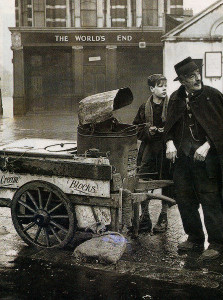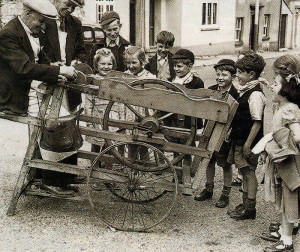
We would be up early on a Good Friday in the 1930s eagerly waiting to hear the cry “Hot Cross Buns, Hot Cross Buns, Buy your buns fresh”.
Out we would run to stop the lad with his large basket, followed by mother ready to buy our breakfast. The buns made early that morning by the baker were indeed fresh and they were delicious -nothing like Hot Cross buns wrapped in packets that we are offered today.
The favourite street vendor of the children was the ‘Stop Me and Buy One’ ice-cream man. His vehicle would make people turn and stare today. He had a bicycle saddle, back wheel and pedals, but the front of this contraption was a large dark blue box on two wheels which held delicious Walls ice-cream. On the front of the box were the well-known words ‘Stop Me and Buy One.’
A round lid on top was removed and we were able to buy tubs, bricks and Snofruits. The bricks cost two old pence and were sold with two wafers.
My favourite was the triangular shaped Snofruit costing one old penny. It was wrapped in a dark blue and white check cardboard wrapper. You peeled the cardboard back and sucked the long bar of fruit flavoured ice – bliss! Snofruits had a milky appearance and there was a plain fruit ice bar as well.
The vendor cycled around the streets ringing his bell, which was louder than an ordinary bicycle bell until stopped by a customer.
Another street vendor I remember was the knife-grinder, who pushed his knife grinding equipment around the streets knocking on people’s doors plying his trade. Out would come the knives and scissors that had become blunt since his last visit. He usually made a good job of sharpening them.
Gypsies came round regu-
larly selling from a large basket clothes pegs, lavender bags, flowers and other small articles they had made. According to the gypsies, you would have good luck if you bought something from them – and bad luck if you didn’t.
When we went into town, there were so many other types of street vendor. We would see women selling bunches of violets in huge baskets; unemployed men injured in the first World War selling matches from a tray hung round their necks. Some who had lost both their legs sat on small trolleys either selling matches or begging.
The unemployed used to walk through the streets singing popular songs and we would run out to put pennies in their hats.

In those days, the milkman came round with churns of milk on his horse-drawn cart and housewives went out with their milk jugs. He dipped his measuring cup into the churn and filled the jugs. The horses knew the round as well as their masters.
Another vendor in the main shopping areas was the chestnut man. He sat beside his brazier with his fire well lit roasting chestnuts and calling
out “Chestnuts, hot chestnuts, come and buy.”
In the streets, the lamp-lighter was a part of our lives before the last war. He came
round on his bicycle every night as dusk set in. He had a long pole with an S-shaped metal piece on the side with a ‘flame’ on top. He stopped at every street light, pulled a ‘switch’ down with his pole and ignited the gas mantle without actually getting off his bicycle.
I used to wish I had been alive when the cats’ meat man came round followed by all the cats in the district. He sold four pieces of horse flesh on a skewer for a penny. I found this intriguing but it happened long before I was born.
With very few cars around, the streets seemed to be more colourful in those days – there was always something interesting going on.
Angela Tippetts








